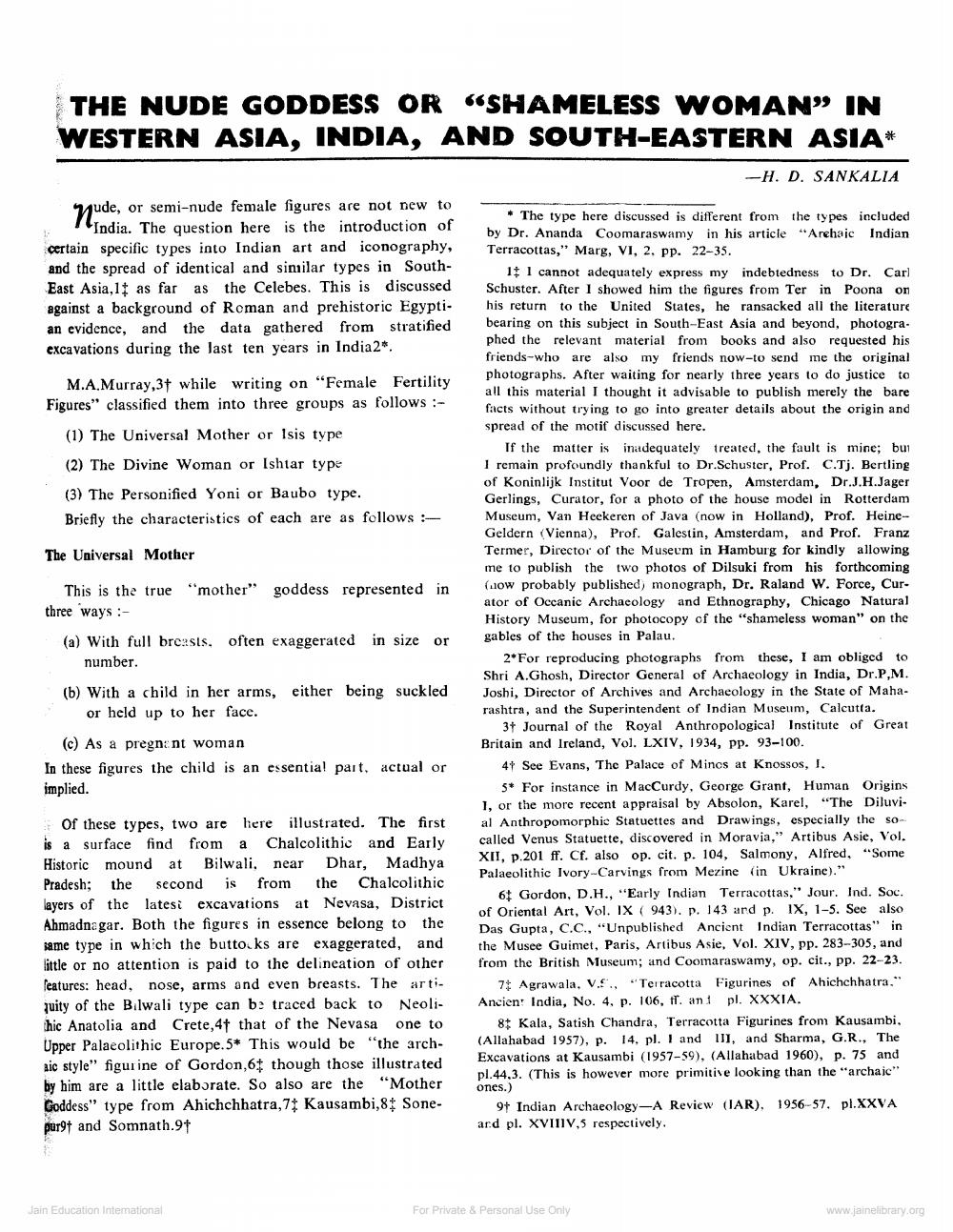________________
THE NUDE GODDESS OR "SHAMELESS WOMAN" IN WESTERN ASIA, INDIA, AND SOUTH-EASTERN ASIA*
-H. D. SANKALIA
nude, ude, or semi-nude female figures are not new to India. The question here is the introduction of certain specific types into Indian art and iconography, and the spread of identical and similar types in SouthEast Asia, 1 as far as the Celebes. This is discussed against a background of Roman and prehistoric Egyptian evidence, and the data gathered from stratified excavations during the last ten years in India2*.
M.A.Murray, 3 while writing on "Female Fertility Figures" classified them into three groups as follows :
(1) The Universal Mother or Isis type
(2) The Divine Woman or Ishtar type
(3) The Personified Yoni or Baubo type. Briefly the characteristics of each are as follows:The Universal Mother
This is the true "mother" goddess represented in three ways:
(a) With full breasts, often exaggerated in size or number.
(b) With a child in her arms, either being suckled or held up to her face.
(c) As a pregnant woman
In these figures the child is an essential part, actual or implied.
Of these types, two are here illustrated. The first is a surface find from a Chalcolithic and Early Historic mound at Bilwali, near Dhar, Madhya Pradesh; the second is from the Chalcolithic layers of the latest excavations at Nevasa, District Ahmadnagar. Both the figures in essence belong to the same type in which the buttocks are exaggerated, and little or no attention is paid to the delineation of other features: head, nose, arms and even breasts. The artiquity of the Bilwali type can be traced back to Neolithic Anatolia and Crete,4† that of the Nevasa one to Upper Palaeolithic Europe. 5* This would be "the archaic style" figurine of Gordon,6 though those illustrated by him are a little elaborate. So also are the "Mother Goddess" type from Ahichchhatra, 7+ Kausambi,8 Sonepur9† and Somnath.9†
Jain Education International
*The type here discussed is different from the types included by Dr. Ananda Coomaraswamy in his article "Archaic Indian Terracottas," Marg, VI, 2, pp. 22-35.
1 I cannot adequately express my indebtedness to Dr. Carl Schuster. After I showed him the figures from Ter in Poona on his return to the United States, he ransacked all the literature bearing on this subject in South-East Asia and beyond, photographed the relevant material from books and also requested his friends-who are also my friends now-to send me the original photographs. After waiting for nearly three years to do justice to all this material I thought it advisable to publish merely the bare facts without trying to go into greater details about the origin and spread of the motif discussed here.
If the matter is
inadequately treated, the fault is mine; bu I remain profoundly thankful to Dr.Schuster, Prof. C.Tj. Bertling of Koninlijk Institut Voor de Tropen, Amsterdam, Dr.J.H.Jager Gerlings, Curator, for a photo of the house model in Rotterdam Museum, Van Heekeren of Java (now in Holland), Prof. HeineGeldern (Vienna), Prof. Galestin, Amsterdam, and Prof. Franz Termer, Director of the Museum in Hamburg for kindly allowing me to publish the two photos of Dilsuki from his forthcoming (now probably published) monograph, Dr. Raland W. Force, Curator of Occanic Archaeology and Ethnography, Chicago Natural History Museum, for photocopy of the "shameless woman" on the gables of the houses in Palau.
2*For reproducing photographs from these, I am obliged to Shri A.Ghosh, Director General of Archaeology in India, Dr.P,M. Joshi, Director of Archives and Archaeology in the State of Maharashtra, and the Superintendent of Indian Museum, Calcutta.
3 Journal of the Royal Anthropological Institute of Great Britain and Ireland, Vol. LXIV, 1934, pp. 93–100.
4 See Evans, The Palace of Mincs at Knossos, I.
5 For instance in MacCurdy, George Grant, Human Origins 1, or the more recent appraisal by Absolon, Karel, "The Diluvial Anthropomorphic Statuettes and Drawings, especially the socalled Venus Statuette, discovered in Moravia," Artibus Asie, Vol. XII, p.201 ff. Cf. also op. cit. p. 104, Salmony, Alfred, "Some Palaeolithic Ivory-Carvings from Mezine (in Ukraine)."
6 Gordon, D.H., "Early Indian Terracottas," Jour. Ind. Soc. of Oriental Art, Vol. IX (943). p. 143 and p. IX, 1-5. See also. Das Gupta, C.C., "Unpublished Ancient Indian Terracottas" in the Musee Guimet, Paris, Artibus Asie, Vol. XIV, pp. 283-305, and from the British Museum; and Coomaraswamy, op. cit., pp. 22-23.
7 Agrawala, V., "Terracotta Figurines of Ahichchhatra." Ancient India, No. 4, p. 106, ff. and pl. XXXIA.
8 Kala, Satish Chandra, Terracotta Figurines from Kausambi, (Allahabad 1957), p. 14. pl. I and III, and Sharma, G.R., The Excavations at Kausambi (1957-59), (Allahabad 1960), p. 75 and pl.44.3. (This is however more primitive looking than the "archaic" ones.)
9+ Indian Archaeology-A Review (IAR), 1956-57. pl.XXVA and pl. XVIIIV,5 respectively.
For Private & Personal Use Only
www.jainelibrary.org




